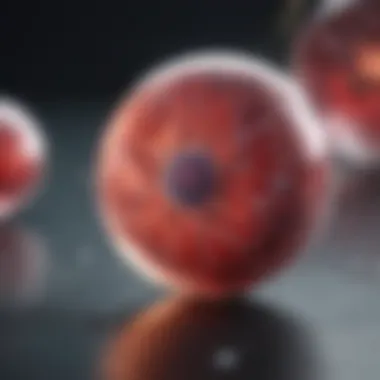Understanding Incucyte Excitation Emission Dynamics


Intro
In the realm of cell biology, understanding the mechanisms of cell behavior and interaction is crucial. Technologies such as IncuCyte excitation emission have become vital tools in achieving these insights. This article unpacks the core principles of IncuCyte excitation emission and delves into its various applications within scientific research. We will explore how this method increases the precision and efficiency of experiments, shedding light on cellular dynamics in real-time.
Key Findings
Summary of the main results
The IncuCyte system operates on the principle of exciting fluorescently tagged cells and measuring the emitted light as a response. Key findings from recent studies include:
- Enhanced imaging capabilities that allow for continuous monitoring of live cell behavior.
- The ability to quantitatively analyze cellular processes such as cell proliferation, migration, and death in various environments.
- Significant improvements in data accuracy compared to traditional methods, particularly in high-throughput assays.
These results underscore the utility of IncuCyte technology in producing reliable data within a shorter timeframe.
Significance of findings within the scientific community
IncuCyte technology offers significant advantages over conventional microscopy. Its real-time monitoring capabilities allow researchers to gather data continuously, thus removing the subjectivity often present in manual analysis. This technology is particularly beneficial for experiments involving time-sensitive processes, providing an unprecedented depth of analysis. The findings also contribute to a more robust understanding of cell behavior and interaction, which can influence broader biological models.
Implications of the Research
Applications of findings in real-world scenarios
The implications of IncuCyte excitation emission extend across various fields:
- Cancer Research: Understanding tumor growth patterns and cellular responses to treatments.
- Pharmacology: Investigating drug efficacy and mechanisms in dynamic environments.
- Tissue Engineering: Monitoring the development and health of engineered tissues over time.
These applications provide researchers with vital tools for advancing their experiments and improving outcomes across numerous disciplines.
Potential impact on future research directions
As the technology continues to develop, it is anticipated that the applications of IncuCyte will expand, leading to more refined methodologies and innovative experimental designs. This growth can further influence areas such as personalized medicine and regenerative therapies. The potential to extract a wealth of data from biological processes will likely shape future research directions, ultimately enhancing our understanding of complex biological systems.
"IncuCyte technology represents a paradigm shift in how researchers approach cellular studies, enabling a level of detail previously unseen in real-time analysis."
Integrating these findings into everyday research practices signifies a pivotal advancement in the effort to decode the complexities of cell biology.
Preamble to Incucyte Technology
Understanding the fundamentals of Incucyte technology is crucial for comprehending its impact on modern biological research. This technology provides a unique means for real-time monitoring of cell behavior, leading to valuable insights in various research domains.
Historical Development
The evolution of Incucyte technology began with the need for more advanced methods in cell analysis. Traditional assessment techniques often lacked the capacity for real-time observation, which limited the scope of experiments. As cellular biology advanced, the demand for a system that could offer continuous live imaging emerged. The initial designs enabled basic imaging operations, but as technology progressed, enhanced features were integrated into Incucyte systems.
Research teams worldwide embraced this technology, particularly in cancer research and drug development, recognizing its potential to transform conventional methodologies. The incorporation of diverse imaging modes and automated analysis marked a significant leap forward, solidifying Incucyte as a fundamental tool in the scientific community.
Key Features of Incucyte Systems
Several defining characteristics make Incucyte systems especially powerful in biological studies:
- Real-Time Imaging: Continuous monitoring of cellular processes in real time enables detailed analysis of dynamic biological changes.
- Various Imaging Modes: Incucyte systems support multiple imaging techniques, such as phase contrast, fluorescence, and brightfield, allowing researchers to choose the best mode for their specific needs.
- User-Friendly Interface: With an intuitive software platform, researchers can easily analyze data and customize their imaging settings, increasing efficiency in experimental design.
- Automated Analysis: The technology includes built-in algorithms that facilitate rapid and accurate quantitation of cellular responses.
- Versatile Applications: It is applicable for studies in apoptosis, cell proliferation, and more, thus expanding the range of research possibilities.


These features collectively enhance experimental outcomes, permitting deeper investigation into cellular activities and responses. As a result, Incucyte technology stands out as a vital instrument in advancing cell biology and related sciences.
Fundamental Principles of Excitation Emission
Understanding the fundamental principles of excitation and emission is critical for anyone working with Incucyte technology. This technology relies heavily on the interactions between light and biological samples, forming the basis for effective imaging and analysis in cell biology. Comprehending these principles helps to grasp how Incucyte systems measure and interpret the biological responses of cells under various conditions. By mastering these concepts, researchers can better design their experiments and optimize data collection, maximizing the insights obtained from their studies.
The Basics of Light Spectra
Light spectra play a valuable role in excitation emission. Light, composed of various wavelengths, can be categorized into different spectral regions, notably ultraviolet, visible, and infrared light. In the realm of biochemical analysis, specific wavelengths interact with certain fluorescence markers attached to cells or biological materials. The right choice of wavelength ensures effective excitation of these markers.
In Incucyte systems, the light sources used are typically filtered to emit specific wavelengths. These are crucial for targeting the excitation of fluorophores, which are substances that re-emit light upon absorbing certain wavelengths. By choosing the optimum wavelengths, researchers can achieve clearer and more defined signals, leading to improved data fidelity.
- Ultraviolet Light: Commonly used for exciting fluorophores, promoting their emission.
- Visible Light: Often utilized for detection and imaging since the human eye perceives this range.
- Infrared Light: Useful in various applications for minimizing the photodamage to biological samples.
This interplay between different light spectra and biological samples lays the groundwork for further understanding of cell behavior and biochemical processes.
Process of Excitation and Emission
The process of excitation and emission involves several steps that are fundamental to the performance of Incucyte systems. The cycle begins when light from a source hits the fluorophore. This energy absorption causes the fluorophore to elevate to an excited state. As it reverts to its original state, it emits light at a longer wavelength. This phenomenon is known as fluorescence.
Here’s a brief overview of this process:
- Excitation: Light energy is absorbed by a fluorophore, transitioning it to an excited state.
- Relaxation: After a short duration, the excited fluorophore returns to a lower energy state.
- Emission: The fluorophore releases energy in the form of light. This light is measured by the detection systems in Incucyte technology.
Understanding this sequence is vital as the emitted light carries significant information about cellular characteristics and responses. The intensity and wavelength of the emitted light can indicate the concentration of fluorophores, which correlates with the biological processes being studied.
"The efficiency of the excitation emission process directly impacts the quality of data obtained through the Incucyte system."
In summary, the foundational principles of excitation emission are crucial for the successful application of Incucyte technology. By mastering the basics of light spectra and the process of excitation and emission, researchers are better positioned to harness this technology for advanced insights in cellular biology.
Technical Aspects of Incucyte Excitation Emission
Understanding the technical aspects of Incucyte excitation emission is essential to grasp how this technology functions within the realm of cellular analysis. These aspects contribute significantly to the robustness and accuracy of the data generated in various experimental settings. One must consider the specific components involved, the light sources employed, and the detection systems that capture the emissions. Each element enhances the technology's functionality, facilitating a more profound understanding of cellular behavior.
Light Sources Used
In Incucyte systems, the light source plays a crucial role. Different types of light sources are utilized to initiate the excitation process:
- LEDs (Light Emitting Diodes): They are favored for their efficiency and specific wavelength capabilities. LEDs provide stable output and longevity, making them suitable for long-term experiments.
- Lasers: In some configurations, lasers are employed for their precision. They can provide higher intensity at specific wavelengths, resulting in improved signal strength and resolution during imaging.
- Fluorescent Lamps: These are less common but can be used in certain applications where broader light spectra are needed. However, their lower intensity compared to LEDs and lasers may limit their effectiveness.
These sources need to be selected based on the requirements of the experiment, including the type of cells under study and the particular assays being performed. The choice of light source directly affects the quality of the excitation and the resulting emission signal.
Detection Systems Explained
Detection systems are another pivotal component in Incucyte excitation emission technology. They are responsible for capturing and interpreting the emitted light after excitation has taken place. The following detection methods are commonly employed:
- Photomultiplier Tubes (PMTs): Known for their sensitivity, PMTs can detect low light levels emitted by fluorescent markers. They are often used for quantitative assays, where subtle changes in fluorescence need to be measured precisely.
- Charge-Coupled Devices (CCDs): These cameras are used for high-resolution imaging. They can capture response from multiple wavelengths, making them versatile for a range of applications, including multiplexing assays.
- Array Detectors: Sometimes, array detectors may be used for simultaneous detection across different wavelength bands. This can provide valuable data in a shorter amount of time.
The detection system's effectiveness influences the data's reliability and the interpretation of cellular behaviors under study. Therefore, integrating the right detection methodology with the appropriate light source is critical for successful experimentation.
In summary, the technical aspects of Incucyte excitation emission are foundational to its application in cellular biology. Understanding the roles of light sources and detection systems helps researchers tailor their approaches for optimal outcomes. This knowledge enhances the quality of insights drawn from experimental data, guiding future studies.
Applications in Cell Biology


The role of Incucyte excitation emission technology in cell biology has become increasingly vital. This section explores various applications that underscore its significance. In an era where detailed biological insights are essential, Incucyte systems provide a range of capabilities. They enable precise monitoring, enhancing our understanding of cellular processes.
This technology offers numerous benefits. It provides real-time data, allowing researchers to observe cell behavior as it occurs. This can lead to significant discoveries that are not possible with traditional methods. Moreover, the ability of the Incucyte to analyze cells in a non-invasive manner preserves the integrity of the samples, which is essential for many experiments.
Below are some key considerations about applications in cell biology:
- Real-time monitoring: This accelerates research by providing immediate feedback on experiments.
- Accurate results: The technology minimizes human error and variability in data collection.
- Diverse applications: From drug development to toxicity testing, the possibilities are vast.
These elements highlight the importance of incorporating Incucyte technology into cell biology studies, setting a strong foundation for future innovations.
Real-Time Cell Analysis
Real-time cell analysis is one of the stand-out features of Incucyte systems. This capability allows researchers to gather data on cell behavior continuously over significant periods. The ability to monitor changes and reactions in live cells provides insight into cell dynamics, which is crucial for understanding numerous biological processes.
One of the primary benefits of real-time analysis is the information it generates. Researchers can study processes such as cell migration, morphological changes, and responses to treatments in their natural environment. For example, in cancer research, real-time analysis can reveal how cancer cells respond to therapies over time. It enables a dynamic understanding of effectiveness and survival, leading to more tailored therapeutic approaches.
Additionally, real-time cell analysis fosters collaboration among various fields. Biologists, chemists, and pharmacologists can utilize this technology to share knowledge and techniques. This interdisciplinary cooperation enhances the research quality and speeds up developments in cellular studies.
Monitoring Cell Proliferation
Monitoring cell proliferation is essential for many applications in biotechnology and pharmaceutical development. Incucyte systems provide accurate and reliable methods to analyze cell growth and division. This capability is crucial for assessing the effectiveness of treatments and understanding cellular responses under different conditions.
In practical terms, the technology tracks changes in cell confluency, which reflects growth rates over time. This real-time data can be pivotal in screening drug candidates, as researchers can determine which compounds effectively inhibit or promote cell growth. Furthermore, the non-invasive nature of the analysis means samples remain usable for follow-up experiments, adding value to the research process.
Furthermore, the ability to monitor proliferation in different cell lines helps in characterizing unique cellular responses. For example, stem cells may behave differently under various conditions than cancer cells. Understanding these dynamics can lead to improvements in regenerative medicine and cancer therapies.
Real-time monitoring and accurate data are essential for today's sophisticated cell biology research. Incucyte systems provide the tools necessary to advance our understanding dramatically.
In summary, the applications of Incucyte excitation emission technology in cell biology, particularly in real-time cell analysis and monitoring proliferation, illustrate its pivotal role in contemporary research. By integrating these systems, researchers can achieve a higher level of insight and precision in their studies.
Integration with Other Technologies
The integration of Incucyte excitation emission with other technologies greatly enhances the scope and precision of experiments in cell biology. This integration allows researchers to draw data from multiple sources, thus enriching the understanding of cellular behaviors and characteristics. By combining various techniques, scientists can utilize the strengths of each method, leading to more comprehensive analyses and discoveries.
Combining with Flow Cytometry
Flow cytometry is a powerful tool for analyzing the physical and chemical characteristics of cells. When combined with Incucyte technology, it allows for a more detailed investigation of cell populations. This synergy enhances the ability to evaluate cell viability, size, granularity, and the presence of specific markers.
Benefits of this integration include:
- High-throughput analysis: Flow cytometry can rapidly assess thousands of cells, while Incucyte technology provides visual data over time.
- Enhanced data correlation: Researchers can correlate live-cell imaging data with flow cytometric parameters, offering a fuller picture of the experimental conditions and cellular responses.
- Versatile applications: This combination can be particularly useful in drug screening, immunology, and cancer research, where detailed characterization of cell populations is crucial.
Utilizing Advanced Imaging Techniques
Advanced imaging techniques, such as confocal or multiphoton microscopy, can complement Incucyte systems significantly. These methods provide high-resolution, three-dimensional images of cells. This is invaluable for understanding cellular interactions in complex environments.
Some key aspects of combining Incucyte with advanced imaging include:
- Improved spatial resolution: This integration allows for detailed visualization of cellular processes, such as migration, adhesion, and morphology changes.
- Temporal analysis: Advanced imaging can be synchronized with Incucyte observations, providing insights into dynamic processes in real time.
- Quantitative analysis: By linking imaging data with the quantitative outputs from Incucyte, researchers can better assess factors like fluorescence intensity or local cellular concentrations.
"The integration of technologies is not just advantageous; it is essential for modern cellular research, allowing us to tackle complex biological problems that were previously out of reach."
In summary, integrating Incucyte technology with flow cytometry and advanced imaging techniques opens up new avenues for research. It not only enhances the data quality but also offers a broader understanding of cellular phenomena, crucial for advancements in therapeutic developments and biological insights.


Challenges and Limitations
Understanding the challenges and limitations surrounding Incucyte excitation emission is crucial for both practical applications and future research. Recognizing these issues can help scientists and researchers refine their methodologies and achieve more accurate results. This section will explore two main areas: technical constraints and the interpretation of data.
Technical Constraints
While the Incucyte system offers remarkable capabilities, it is not without its technical challenges. One of the primary limitations arises from the precision required in calibration. The optics involved in excitation and emission must be meticulously aligned, and any deviations can lead to substantial inaccuracies in the measurements.
Moreover, the choice of light sources plays a pivotal role. Different cell types can exhibit varying responses to particular wavelengths. If the selected light source does not match the excitation needs of the fluorescent markers used, it can significantly affect the efficiency of the process.
Other technical constraints include:
- Sample Preparation: The requirement for optimal sample conditions can impose limits on experimental design, sometimes necessitating tedious pre-processing steps.
- Environmental Factors: Incucyte systems also depend on controlled environmental conditions such as humidity, CO2 levels, and temperature. Any fluctuations might affect cell behavior, leading to inconsistent results.
Interpretation of Data
Interpreting data generated from Incucyte excitation emission involves its own complexities. The outcome can be misinterpreted due to various factors, including the inherent fluorescence of non-target components in the sample. Background noise can obscure the desired signal, complicating the analysis process and leading to erroneous conclusions.
Furthermore, due to the automated nature of data collection in Incucyte systems, there is a potential for over-reliance on the software algorithms for analysis.
- Critical considerations while interpreting data include:
- Threshold Settings: The determination of appropriate thresholds for detection is subjective. Poorly set thresholds may lead to false positives or negatives.
- Statistical Analysis: It is important to apply robust statistical methods to validate findings, as improper analysis could compromise the reliability of results.
It is essential to understand the limitations inherent in any measurement system to ensure accurate scientific inquiry.
Ultimately, a comprehensive understanding of these challenges helps guide appropriate experimental design and fosters the development of strategies to mitigate the impacts of these limitations.
Future Directions in Research
Understanding the future directions in the realm of Incucyte excitation emission is crucial in comprehending its full potential within biological research. The landscape of cell biology is rapidly evolving. As new methodologies and technologies emerge, the need for innovative approaches in therapeutic applications and cellular studies grows significantly. This section will outline potential advancements, exploring how Incucyte excitation emission can play a pivotal role in these developments.
Innovative Applications in Therapeutics
Therapeutics are at the heart of applying scientific findings into meaningful medical interventions. The unique capabilities of Incucyte excitation emission offer several promising applications. One major aspect is the monitoring of drug responses in real-time. This allows researchers to track how cells react to various treatments instantaneously, providing valuable insights into effective therapeutic strategies.
- Real-time observation: Unlike traditional methods, which can introduce delays, Incucyte systems enable continuous monitoring of cellular changes as they occur. This immediacy enhances the relevance of data collected during experimentation.
- Personalized medicine: With the ability to analyze individual cellular responses, researchers can tailor therapies based on how specific cell types respond to drugs. This approach could lead to more effective, patient-specific treatments.
- High-throughput screening: The system facilitates evaluating many compounds against cell lines simultaneously, significantly speeding up the drug discovery process. Researchers can identify compounds that induce desired cellular effects in less time.
In summary, as we look towards therapeutic applications, the operational versatility of Incucyte systems indicates exciting possibilities in enhancing treatment efficacy.
Emerging Trends in Cellular Studies
On the front of cellular studies, the integration of Incucyte excitation emission showcases transformative trends. The adoption of this technology is spurred by various factors. Here are a few noteworthy trends:
- Increased focus on cellular dynamics: The ability to capture dynamic behavior of cells as they grow, differentiate, or respond to stimuli has become essential. Incucyte allows for the detailed observation of these processes.
- Investigating cell-cell interactions: Understanding how different cell types communicate can reveal critical information about tissue function and disease mechanisms. Incucyte systems excel at observing these interactions over time.
- Integration with artificial intelligence: The application of AI in analyzing vast amounts of data generated by Incucyte has the potential to uncover patterns and insights that might be overlooked by human analysis.
End
The conclusion of this article emphasizes the pivotal role of Incucyte excitation emission in modern biological research. As the scientific community increasingly leans on precision and real-time analysis, understanding this technology becomes essential. The mechanisms behind excitation emission not only deepen our knowledge of cellular processes but also enhance experimental reliability.
Summation of Key Points
In reviewing the critical aspects discussed, several key points stand out:
- Foundation in Light Spectra: Understanding light spectra is crucial for utilizing Incucyte systems effectively. It provides the basis for excitation and subsequent emission processes.
- Real-Time Data Acquisition: The ability to gather data in real time significantly impacts cell biology studies, allowing researchers to observe dynamic biological processes as they unfold.
- Integration with Other Technologies: The ability to combine Incucyte with techniques such as flow cytometry and advanced imaging opens new avenues for research, providing a more comprehensive view of cell behavior.
- Addressing Challenges: Awareness of technical limitations and data interpretation complexities is necessary to navigate and overcome hurdles in research.
Final Thoughts on Incucyte Excitation Emission
In closing, Incucyte excitation emission not only serves as a valuable tool in cell biology but also embodies the ongoing evolution of scientific inquiry. Its methodical approach to understanding cellular behaviors through light manipulation represents a significant advancement in research methodologies. The future of cell biology clearly holds promise, and with tools like Incucyte, researchers are better equipped to unlock the complexities of cellular mechanisms. This technology showcases the synergy between innovation and practical application in scientific research.







